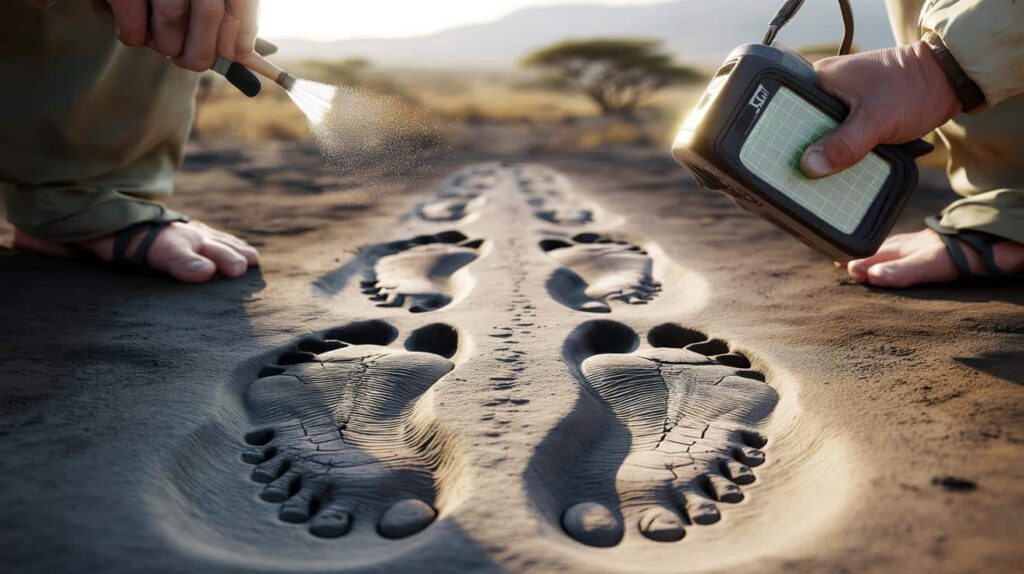They left a soft impression trail, preserved in volcanic ash, resembling a message trapped beneath glass. A recent discovery of footprints in northern Tanzania now reveals something scientists had longed to observe but had never truly documented in the earth itself: two extinct human ancestors traversing the same ancient terrain, side by side. It’s not a fossilized skull or a broken tool. It’s a moment in time.
The morning air at Laetoli remains still before the sun becomes harsh. A field team crouches with brushes and spray bottles, uncovering small secrets from the ash. Heel, arch, toes—one tidy print after another—as if a walker had just stepped away for a drink. Then another trail appears, with a different shape and rhythm, crossing the first like a whisper. Someone whistles softly. Another person retrieves the 3D scanner. Two sets of footprints. Same surface. Same day, perhaps the same hour. The ground remembers.
Two species, one ash-gray moment
Laetoli is renowned for its footprint wonders, but this is unprecedented. On a single layer of ash deposited approximately 3.66 million years ago, researchers have re-exposed and re-measured tracks that do not correspond to the well-known Australopithecus afarensis lineage. The second trail exhibits a unique, cross-stepping gait and a foot shape that is broader in the forefoot, with a distinct pressure signature. **Two species. One surface.** Not a theory derived from teeth found in different caves. A shared pathway inscribed in pressure and movement.
Consider it like a snapshot at a street corner. One walker leaves prints that fit the classic A. afarensis profile: a narrower midfoot, a big toe pushing off in a smooth arc, and a stride moving along at a steady pace. Nearby, another walker moves with a slight inward swing, as if their steps intersect the centerline. The track lengths in this second trail are shorter, the big toe is positioned differently, and the heel-to-toe depth gradient tells a different foot story. 3D models reveal two distinct morphologies—not a single variable foot, but two patterns coexisting in the same hour of ash.
The significance of this discovery is profound. Bones can be displaced by rivers and time, so “same place” doesn’t always imply “same moment.” Footprints are different. They capture behavior in the instant of contact. Here, two extinct hominin types walked the same still-wet surface, which makes the diversity of early human ancestors resemble a sidewalk during rush hour rather than a ladder. It doesn’t imply they conversed or hunted together. It does suggest that the landscape accommodated at least two ways of being human simultaneously—one familiar, one still enigmatic.
How to interpret ancient steps like a field expert
Begin with the heel. It serves as your anchor to the body above the print, the first indication of weight and direction. **Pay attention to the heel-to-toe depth change,** then trace the pressure from the big toe through the ball of the foot. Next, examine toe splay: a wider spread can indicate different foot stiffness or gait choices. If you need a quick, rough height estimate, multiply foot length by about 6.25 to 6.8—an imperfect guideline, but sufficient to visualize the walker in your mind.
Don’t interpret a single print as if it were a novel. Most truths are concealed in the rhythm across multiple steps. Observe the cadence: equal step lengths, consistent angles, repeating pressure. And be gentle with yourself. “We’ve all experienced that moment when a smear of mud resembles a mystery.” Bear prints, for instance, can mimic a human-like shape when front and hind prints overlap. Let’s be honest: nobody actually does that every day. Fieldwork is chaotic. The key is to slow down until the ground stops telling you what you wish to hear and begins to reveal what it remembers.
This new moment at Laetoli imparts lessons in patience and humility. Different species can share a surface without sharing a narrative, and that remains exhilarating.
It felt as if the ash was still moist, as though you could press your own foot in and join the line.
- Start with heel depth, followed by toe-off power.
- Observe toe splay and big-toe angle for clues about foot stiffness.
- Check midfoot pressure to identify arch and gait style.
- Focus on stride rhythm rather than the drama of a single print.
What the overlap reveals about us
Laetoli’s dual trail challenges the comforting narrative of one lineage stepping neatly into the next. Multiple hominin species traversed the same hills, experienced the same winds, and likely gazed at the same fruiting trees. This suggests a mosaic of bodies and behaviors, each adapted to slightly different survival strategies. Perhaps one foot preferred speed over rough terrain, while the other prioritized grip and pivoting in thorny scrub. Maybe they avoided one another. Maybe they didn’t. **This alters how we envision deep time.** It becomes less like a museum corridor and more like a vibrant street.
| Key Point | Detail | Reader Interest |
|---|---|---|
| Footprint “duet” on one ash layer | Two distinct hominin trackways preserved together at Laetoli | Clear, straightforward evidence of side-by-side existence |
| Different foot shapes and gaits | Toe splay, heel depth, stride angles do not align with a single species | Demonstrates real diversity that can be visualized without complex terminology |
| From ladder to sidewalk | Human evolution as overlapping lives, rather than a single-file line | Makes deep time feel relatable, chaotic, and alive |
FAQ :
- Is this truly the first instance of two extinct human ancestors being observed together?In terms of footprint evidence, yes—this is the most compelling case of two hominin species sharing the same surface at the same moment. Skeletons may imply overlap, but prints capture a shared instant.
- Which species created the tracks?One set corresponds with Australopithecus afarensis (the “Lucy” species). The other belongs to an unidentified hominin with a different foot structure and gait, preserved in the same ash.
- Could one trail belong to a bear or another animal?Teams investigated that. The toe proportions, pressure paths, and step rhythm align much better with a bipedal hominin than with a bear double-print. The cross-stepping gait is unusual, yet still human-like.
- How do scientists date the prints?By dating the volcanic ash layer and then linking the tracks to that specific, time-stamped surface. The prints are found in the same layer, so they share the same timeline.
- What does this change about human evolution?It encourages us to view a community of ancestors, rather than a queue. Evolution becomes a mosaic of bodies and behaviors that overlapped in space and time, sometimes literally under the same sky.








